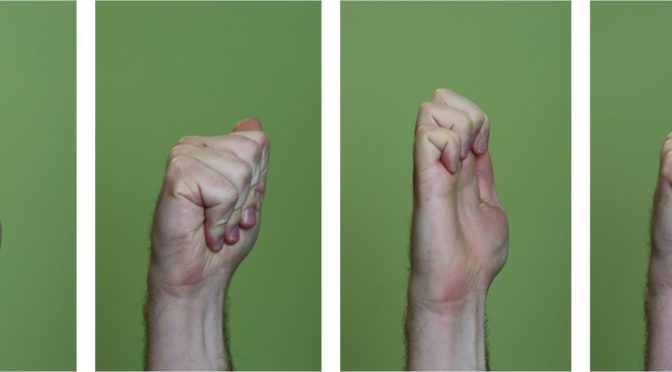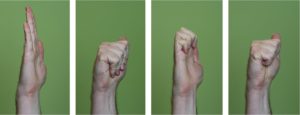by Allison Shearer, MOT, OTR/L, CHT
Due to repetitive motions, instrumentalists are prone to overuse injuries of the wrist and hand. Among those most at risk are string players and percussionists. One problem is de Quervain’s tenosynovitis, a form of tendinitis particularly common in percussionists. This inflammatory condition affects the two tendons in the wrist that control the ability to pull the thumb out and away from the hand. The sheath containing the tendons swells and thickens, irritating the tendons and causing pain on the thumb side of the wrist that can extend into the thumb. Pain often worsens with thumb and wrist motion, gripping, and pinching. For professional musicians, ceasing performance usually isn’t an option. So how can you manage and prevent these symptoms?
Perform Dynamic Stretching
Regardless of whether you’re gearing up for practice or performance, always warm up. Musicians are similar to athletes. They repeatedly perform a high-level skill with extreme precision and focus. Like athletes, a five to 10-minute warm-up of dynamic stretching—stretching through motion—primes the body for playing. Moving your joints through their full available range of motion stimulates blood flow, lubricates joints, and improves flexibility, strength, and body awareness. It can also enhance performance and reduce the likelihood of injury. Try these movements to warm up your wrists and hands.
- arm circles — Hold arms to the side of the body at shoulder height and slowly make smaller-to-larger circles clockwise, then reverse the circles to make larger-to-smaller circles counterclockwise.
- wrist circles — Hold your fingers in a loose fist position and slowly move your wrist in a circular motion both clockwise and counterclockwise.
- thumb opposition — Touch the tip of your thumb to the tip of each finger in an “O” shape and straight out for a stretch.
- tendon gliding exercises for the fingers — See example images below.
Do not perform static stretching—manually stretching soft tissue and joints—prior to playing. This can actually decrease strength. This type of stretching should be saved for after you play to reduce excessive muscular tension.
Check Your Grip
Have an expert in your instrument or a clinician specializing in performing arts medicine check how you are holding and playing your instrument. For example, de Quervain’s in timpanists can be related to how you hold your mallets. Using a French style grip places extra stress on the thumb side of the wrist, irritating the tendons. With a German or American style grip, the forearm is in a more palm-down position and more force is absorbed by the palm and index finger. Modifying your grip—even temporarily—may allow you to continue playing.
Check Your Hearing
Choosing the correct type of hearing protection is essential. Too little protection can put you at risk for hearing loss. Too much protection (industrial-strength, foam-style earplugs) may cause you to “overplay.” Overplay occurs when too much high-frequency sound is filtered out and you compensate by playing louder, strumming or striking the instrument with excessive force. Specialized musicians’ earplugs provide even filtering of low, medium, and high frequency sounds.
Avoid Aggravating Motions
In de Quervain’s, the tendons are aggravated by moving your wrist side-to-side, so avoid pulling too far towards your thumb. Also avoid pulling your thumb far away from your hand—such as when stretching your hand over the top of a jar—and minimize pinching activities. This means changing the way you grasp and lift objects. For example, if you are lifting a frying pan, use a palm-up position to grasp and lift the pan to reduce stress. If you have small children, rather than picking them up by placing your hands underneath their armpits, try to “scoop” them up from underneath, again using the palm-up position.
Seek Medical Attention
If you are experiencing pain that occurs for more than four days, is unbearable, or worsening, seek medical attention. Do not let your pain become unmanageable, as early diagnosis and treatment yield better outcomes. Physicians specializing in performing arts medicine are best suited to assess your symptoms and intervene as appropriate. Participation in a hand therapy rehabilitation program with an occupational or physical therapist is often recommended.
Try Conservative Methods
After diagnosis, doctors typically recommend conservative management techniques to treat tendinitis. A recent onset (two weeks or less) of pain on the thumb side of your wrist likely means that you are experiencing acute inflammation of the tendons and sheaths. To reduced pain and inflammation during this time, apply ice for 10-15 minutes, one to three times per day or after playing. If you have significant or constant pain, you may be advised to use a thumb splint (thumb spica), which puts your wrist in a healthy position for healing.
—Allison Shearer, MOT, OTR/L, CHT, is an occupational therapist specializing in the treatment of musicians’ injuries. She is a member of the Performing Arts Medicine Association, and founder of Resonance Wellness.



